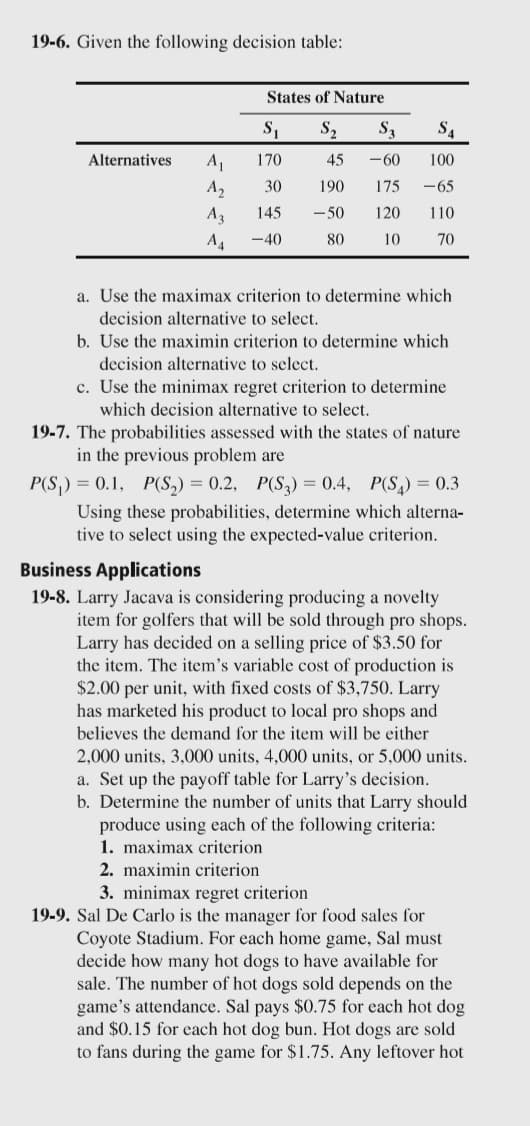a. Use the maximax criterion to determine which decision alternative to select. b. Use the maximin criterion to determine which decision alternative to select. c. Use the minimax regret criterion to determine which decision alternative to select.
a. Use the maximax criterion to determine which decision alternative to select. b. Use the maximin criterion to determine which decision alternative to select. c. Use the minimax regret criterion to determine which decision alternative to select.
Practical Management Science
6th Edition
ISBN:9781337406659
Author:WINSTON, Wayne L.
Publisher:WINSTON, Wayne L.
Chapter9: Decision Making Under Uncertainty
Section9.2: Elements Of Decision Analysis
Problem 2P
Related questions
Question
To be done in excel

Transcribed Image Text:19-6. Given the following decision table:
States of Nature
S₁ S₂ S3
Alternatives A₁
170
45 -60
100
A₂
30
190 175
-65
A3
145 -50 120
110
A4
-40
80
10
70
a. Use the maximax criterion to determine which
decision alternative to select.
b. Use the maximin criterion to determine which
decision alternative to select.
c. Use the minimax regret criterion to determine
which decision alternative to select.
19-7. The probabilities assessed with the states of nature
in the previous problem are
P(S₁) = 0.1, P(S₂) = 0.2, P(S3) = 0.4, P(S) = 0.3
Using these probabilities, determine which alterna-
tive to select using the expected-value criterion.
Business Applications
19-8. Larry Jacava is considering producing a novelty
item for golfers that will be sold through pro shops.
Larry has decided on a selling price of $3.50 for
the item. The item's variable cost of production is
$2.00 per unit, with fixed costs of $3,750. Larry
has marketed his product to local pro shops and
believes the demand for the item will be either
2,000 units, 3,000 units, 4,000 units, or 5,000 units.
a. Set up the payoff table for Larry's decision.
b. Determine the number of units that Larry should
produce using each of the following criteria:
1. maximax criterion
2. maximin criterion
3. minimax regret criterion
19-9. Sal De Carlo is the manager for food sales for
Coyote Stadium. For each home game, Sal must
decide how many hot dogs to have available for
sale. The number of hot dogs sold depends on the
game's attendance. Sal pays $0.75 for each hot dog
and $0.15 for each hot dog bun. Hot dogs are sold
to fans during the game for $1.75. Any leftover hot
S4
Expert Solution
This question has been solved!
Explore an expertly crafted, step-by-step solution for a thorough understanding of key concepts.
This is a popular solution!
Trending now
This is a popular solution!
Step by step
Solved in 6 steps with 6 images

Recommended textbooks for you

Practical Management Science
Operations Management
ISBN:
9781337406659
Author:
WINSTON, Wayne L.
Publisher:
Cengage,

Practical Management Science
Operations Management
ISBN:
9781337406659
Author:
WINSTON, Wayne L.
Publisher:
Cengage,